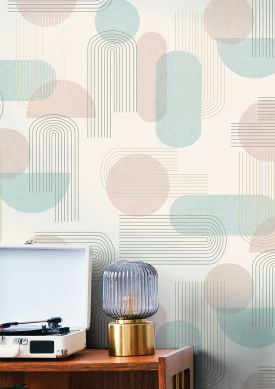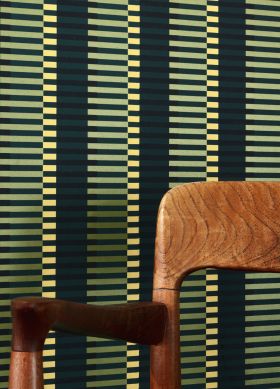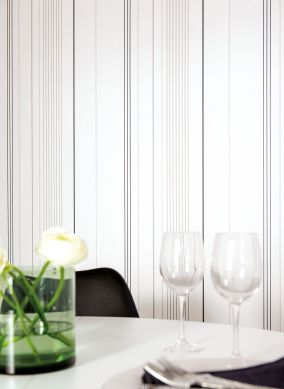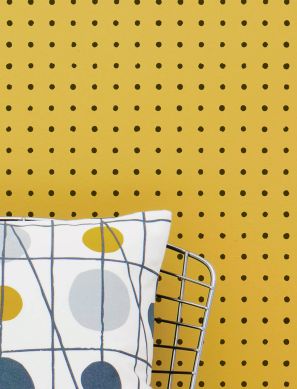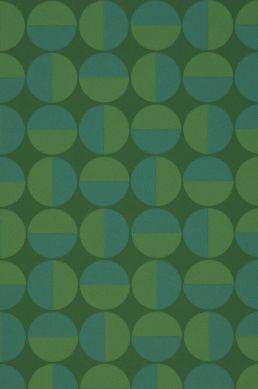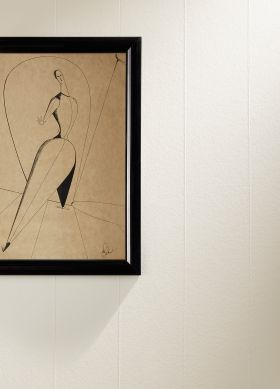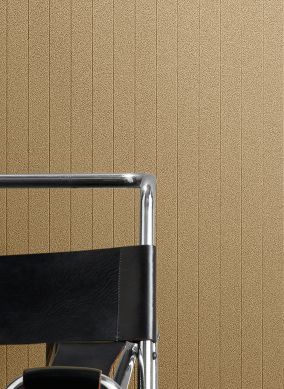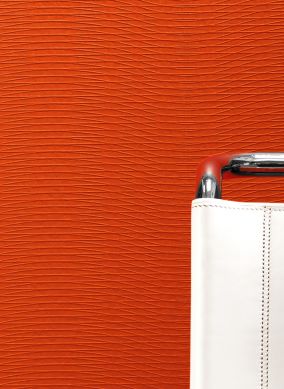Bauhaus Wallpaper
Bauhaus Wallpaper: The Guide
Founded in 1919 by Walter Gropius as a state art school with a focus on artistic reorientation, the Bauhaus style is often equated with timeless modernism in architecture and design. When talking about Bauhaus, what springs to mind immediately are cube-shaped houses with lots of glass, multifunctional geometric furniture and the primary colours red, yellow and blue. World-famous artists such as Paul Klee and Wassily Kandinsky taught at the Bauhaus and encouraged the ingenious designs of their students. Wallpapers in the Bauhaus style exude this creative, experimental spirit in a plethora of ways. They reflect it in the form of reissued original Bauhaus wallpaper designs or as multi-faceted reinterpretations.
Table of Contents
- What is the Bauhaus style?
- What are the special characteristics of the Bauhaus style on wallpaper?
- What are common patterns of Bauhaus wallpaper models?
- Which primary colours are often used on Bauhaus wallpaper designs?
- Where do the Bauhaus patterns of today's wallpapers originate?
- Which rooms are Bauhaus wallpaper models most suitable for?
- Why is Bauhaus-style wallpaper still so popular?
- Which important artists are the inspiration for some of the most popular Bauhaus wallpaper patterns?
- Our tips: Ideas for Bauhaus-style wallpaper projects
What is the Bauhaus style?
At the time of its conception, the Bauhaus style was seen as a place of essence research & an intellectual laboratory. Mathematics served as a basic element of artistic design, combining aesthetics with function and economy.
State Art School
Walter Gropius founded the State College of Fine Arts Bauhaus Weimar in 1919 as a school with workshops for creative crafts, architecture and the arts. He saw the end of the war as a turning point in history and set in motion a reform of artistic work. Although the Staatliches Bauhaus only existed until 1933, it is now considered a trend-setting institution for design and architecture worldwide.
Combining aesthetics with function and economy
Bauhaus design is functional, has a high economic value and exudes its own beauty of form. The aim is to create a total work of art from architecture, sculpture and painting. One of its important design principles, especially with regard to utility objects and furniture, is "Form follows function". This means that ornaments and decorative objects are largely dispensed with.
Mathematics as a basic element of design
Bauhaus design works with basic geometric shapes and bodies, e.g. rectangle, square, triangle, circle and cube. The cubic design language is particularly noticeable in architecture and furniture design. Right angles are also important features. As in mathematics, a few elements provide infinite design options.
Linking art with crafts and mass production
Design was radically rethought at the Bauhaus. Artistry and craftsmanship in the sense of pioneering spirit and development were of great importance, as was the use of new materials and technologies brought about by the industrial age. At the same time, the focus was on reproducibility, i.e. making design accessible to a large audience.
Minimalism
Bauhaus stands for reduction and sees itself as a counter-movement to Art Deco and Art Nouveau, picking up impulses from the British Arts and Crafts movement and the Dutch group "De Stijl". The design is simple and clear, emphasising its minimalism. The practical, sometimes austere design language provides refreshing movement which underlines the functionality of objects.
What are the special characteristics of the Bauhaus style on wallpaper?
Strictly graphic wallpaper patterns are typical for wallpaper models in the Bauhaus style. They thrive on simplicity and subtle aesthetics, are rich in contrast and striking, and reflect their own theory of colour and form, which was influenced by many important artists.
Strictly graphic wallpaper patterns
"Clear order in the system" is the motto of the graphic patterns which follow a strictly structured composition, even if this sometimes seems slightly improvised. The effect reaches its pinnacle via the interplay with striking colours. At the same time, the designs appear very tidy and understated. Viewing angle and side light change the visual effect.
Simplicity and discreet aesthetics
Playful decoration and ornamentation is deliberately avoided. Elegant simplicity creates a discreet, intrinsic beauty that makes the beholder think in unexpected ways. It's all about discovery, recognising oneself in the design, immersing oneself in the orderly play of forms and colours.
Rich in contrast and striking
The use of opposing shapes and bodies as well as the striking primary colours red, yellow, blue, occasionally in combination with white and black, create strong contrasts that give the pattern design its energetic liveliness. The effect unfolds in the room and deliberately takes up space, a fact that requires restraint in terms of the rest of the interior design.
New rules of colour and form
The Bauhaus theory of colours and shapes is a training module with a comprehensive multi-discipline range and relevance. Important teachers such as Johannes Itten, Paul Klee and Wassily Kandinsky rely on basic theories, but they expand on them through their own insights and additions and connect them to mathematical forms and bodies.
What are common patterns of Bauhaus wallpaper models?
Bauhaus design is frequently based on geometric elements; straight lines and stripes help to create and construct the desired forms. Surfaces with structures enhance the design and give it a tactile quality.
Geometric elements
Wallpaper patterns in the Bauhaus style use shapes like rectangles, squares, and triangles to create striking designs; circles and cubes are also popular. Single identical geometric elements/a small number of different geometric elements can be combined to create a pattern. In terms of scale, small and large formats of the pattern elements are equally possible.
Straight lines and stripes
Lines and stripes in different widths and colours are important parts of Bauhaus pattern designs.
They emphasise the clear line of the design and determine the direction of view, almost akin to traffic signs. In addition, ruling grids and dot grids, dashes or herringbone are all part of cult Bauhaus wallpaper pattern designs.
Surfaces with structures
While the first original Bauhaus wallpaper models were still based on small-scale, even delicate geometric patterns which conveyed a structure, original patterns today are emphasised by special materials and techniques to create a sensual feel. With coordinated colours, white wallpaper can be individualised in the spirit of the Bauhaus style and provides a fantastic alternative to smooth walls.
Which primary colours are often used on Bauhaus wallpaper designs?
As with the basic geometric shapes, the motto for the colours is: Less is more. The primary colours red, yellow, blue as well as the "non-colours" black and white are all it takes to create sleek wallpaper designs in line with the Bauhaus theory of colours and shapes.
Red
Johannes Itten (1888-1967) equates the colour red with corporeal matter which appears static and heavy. As a result, it is linked to the square. Russian artist and deputy Bauhaus director Wassily Kandinsky (1866-1944) assigns the colour red to the cube.
Yellow
In Itten's theory of colours, yellow has a weightless character with aggressive and combative aspects, which is why he associates the colour with the mind and with thinking. Thus, yellow is the colour of the triangle. In Kandinsky's work, the colour of the sun stands for warmth and earthliness, but it can also be intrusive and eccentric. He associates it with the three-dimensional body of the pyramid.
Blue
For Itten, blue is a round colour that reflects a mobile mind. It symbolises relaxation and movement in equal measure and, in the Bauhaus colour theory, is linked to the circle. Wassily Kandinsky sees blue as the colour of the sky, which is cold as well as concentric, infinite and supernatural. For him, it embodies the sphere.
Black
For Kandinsky, black as a "colour" is simply dark. Along with grey and white, it is one of the most frequently used contrasting colours on Bauhaus wallpaper. It can also be the dominant colour, while the primary colours are merely used for the details. Conversely - but in line with original Bauhaus patterns - black can be the pattern colour, while a primary colour forms the bright background.
White
Wassily Kandinsky sees white as the colour of brightness. In terms of Bauhaus pattern designs, the colour of purity is often chosen in combination with all three primary colours as well as black and grey and can achieve very striking, demonstrative contrasts. Johannes Itten defines white and black as non-colours that do not occur in his colour circle.
Where do the Bauhaus patterns of today's wallpaper models originate?
The Bauhaus school launched its own wallpapers, which from 1929 onwards became true best-sellers. In addition to new editions of original wallpapers, some of which are given a contemporary touch, there are also many free reinterpretations today.
Original
1929 marks the beginning of the history of Bauhaus wallpaper which is designed by teachers and students and produced by renowned wallpaper manufacturer Rasch. After some initial scepticism, the design wallpaper range developed into a huge best-seller. Since the post-war period, Rasch Bauhaus wallpaper models have been immensely popular, whether they're true to the originals or with classic pattern designs but innovative materials and textures.
New interpretations
New interpretations of original Bauhaus wallpaper designs come from the house of Rasch, which has held the licensing rights since 1933 and can design new collections at its own discretion. On the other hand, there are numerous freelance designers who take up the Bauhaus theme with its fascinating colourful geometry and give it their own touch.
Which rooms are Bauhaus wallpaper models most suitable for?
Wallpapers in the Bauhaus style are perfect for representative rooms such as living rooms, hallways and stairways and give them an exciting modern look. They are also an excellent design element for offices, doctors' surgeries or hotel rooms to create a statement for unconventional design.
Living room
Clear graphic geometry in bright colours or in black/white/grey transforms the living space into a creative design hub that attracts admiring glances. Often it is precisely the simple things that, when skilfully chosen, have a fascinating charm. Depending on the pattern, a feature wall is just as much an option as a design spreading across more than one wall.
Hallway and staircase
Art in buildings - there is no better place for it than in these highly frequented open areas which should offer the eye visual delights. Large-format and colour-intensive designs are particularly suitable for just one specific wall; the remaining walls can be kept in contrasting colours in the Bauhaus style.
Office
In creative jobs as well as professions which require a high level of concentration, strict Bauhaus geometry can be both stimulating and relaxing for body and soul. However, proportionality is key - and it can easily be achieved with a feature wall.
Doctors' surgeries
It may be unusual at first sight, but its psychological effect should not be underestimated. Anyone who enters a doctor's surgery adorned with a modern, striking Bauhaus wallpaper automatically connects this image with his or her first impression. It conveys openness, order, functionality and a feeling for design aesthetics. It has a positive effect on both visitors and patients.
Hotel rooms
If the hotel concept aims at functionality, design and an affordable price, wallpapers in the Bauhaus style emphasise the pioneering philosophy of the Weimar movement. But trendy, stylish hotels that focus on minimalism, purism and geometric design also benefit hugely from Bauhaus wallpaper designs.
Why is Bauhaus-style wallpaper still so popular?
The list of reasons why wallpaper in the Bauhaus style is still popular today is long. They are simple, functional, individual, modern, extravagant and timeless. They concentrate on the essential and provide an escape from everyday life.
Practical, plain and functional
Simple, plain, without frills, but at the same time meaningful, functional and affordable - these were the aims of Bauhaus designs. For many people, this minimalist maxim has not changed to this day; on the contrary, it is increasingly coming back into focus. This is also one of the reasons why utility objects as design classics never go out of fashion.
Modern and extravagant
During the heyday of the Bauhaus movement, its architecture, design, art, teachers and students were considered avant-garde. Modernity determined every aspect. The surprise effect which turned residential facilities into practical objects of utility was perceived as extravagant and progressive. It is precisely this zeitgeist that wallpapers in the Bauhaus style still convey today.
Individual and timeless
One either likes the Bauhaus style, the designs and achievements, or one does emphatically not. Either way, it emphasises the individualistic side of design and was as relevant yesterday as it will be tomorrow. Just as there is not just one Bauhaus style, there is no "typical" Bauhaus wallpaper. Experimentation and innovation do not stand still, they are always in motion.
Enabling concentration & providing a reprieve from the hectic pace of everyday life
Similarly to Kandinsky's antipolar colour associations, the Bauhaus style stands for "opposites that attract". Bauhaus designs on wallpaper promote concentration whilst also providing an escape from our hectic, stressful everyday life.
Which important artists are the inspiration for some of the most popular Bauhaus wallpaper patterns?
The artists who influenced Bauhaus wallpaper patterns with their work also have a share in promoting huge changes in the times of modernism. Among them are Joan Miró, Mies van der Rohe, Walter Gropius and Le Corbusier.
Joan Miró
Spanish-Catalan painter, graphic artist, sculptor and ceramist Joan Miró (1893-1983) is one of the most important representatives of Surrealism and the Modernist movement. Geometric and organic forms as well as animal and human figures are his métier, and he depicts them with great precision, yet in a stunningly simple manner and in striking primary colours.
Mies van der Rohe
German-American architect Ludwig Mies van der Rohe (1886-1969), the third director of the legendary Bauhaus, made history in modern architecture. His steel structures are legendary and form the basis for large glass façades. This true master of the principle "less is more" is considered an advocate of minimalism in architecture.
Walter Gropius
With German architect Walter Gropius (1883-1969), one of the co-founders of modern architecture, an era of future-oriented design began. In 1919, he founded the State Bauhaus in Weimar, thus revolutionising the approach to art and architecture.
Le Corbusier
Charles-Edouard Jeanneret (1887-1965), who became famous under the pseudonym "Le Corbusier", is considered a pioneer of modern architecture and one of the most influential architects of the 20th century. He created the concept of public housing (modernist housing estates), contributed to the idea of industrially produced, prefabricated houses and preferred to work with exposed concrete in a strictly geometrical manner. He also made a name for himself in furniture design.
Our tips: Ideas for Bauhaus-style wallpaper projects
- Room divider shelf with Bauhaus charm: A large room, for instance the living room or dining room, is divided in a stylishly modern way with a graphic-geometric Bauhaus-style pattern motif, which is laminated onto a wide shelf back. Striking primary colours are very suitable for light and predominantly white rooms.
- Lounge with brightly coloured squares: For short or long breaks and relaxed meetings, one wall of the lounge is beautified with a pattern motif consisting of squares and rectangles of different sizes in primary colours as well as black and white. Table and chairs take up the colours of the wallpaper design.
- Hallway in the infinite space of Bauhaus geometry: For wallpapers in the Bauhaus style, rust-red, light blue, corn yellow and pink are all colours that demand attention. A pattern pot-pourri of wide and narrow, vertical and horizontal lines in random arrangements as well as circles or other compositions turn a hallway side wall into a work of art.
- Dot grid in the home office: Le Corbusier's legendary dot grid design, or "Dots" for short, perfectly captures the Bauhaus aura. Its modern and elegantly understated charisma is fantastically well suited to the office at home.






